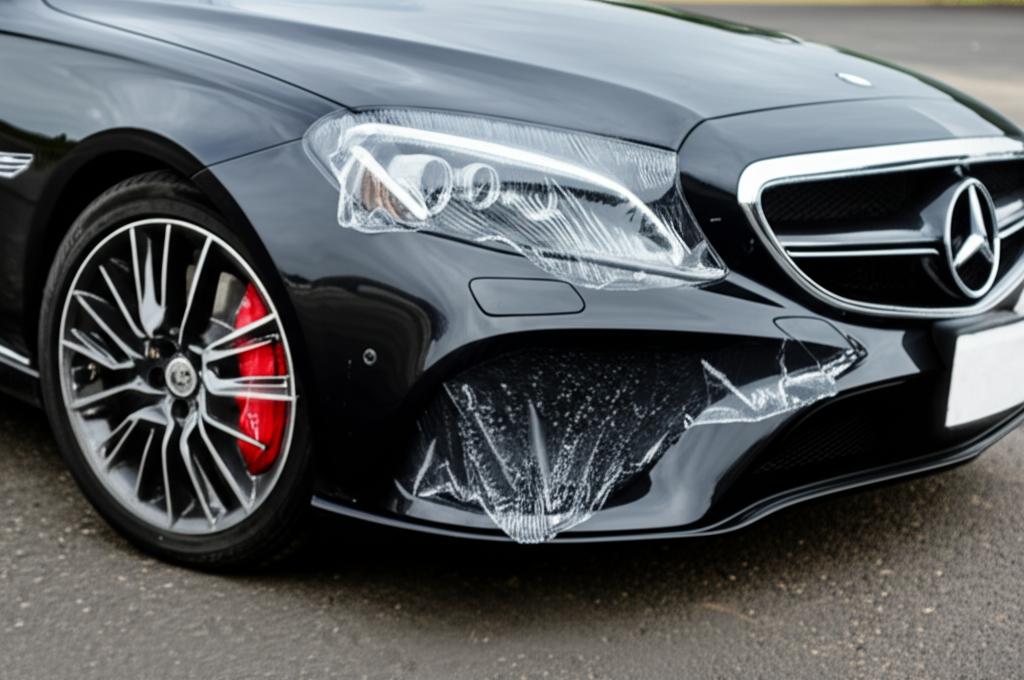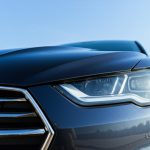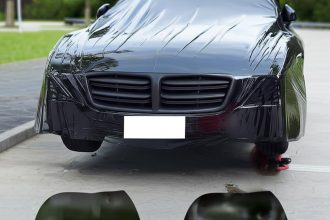You know the feeling. That sinking heart when you see a new scratch on your beloved car. Maybe it was a careless motorbike in traffic, a tight parking spot gone wrong, or just debris on the road. For experienced car owners in Thailand, these moments are frustratingly familiar.
You’ve been through the process: finding a reputable body shop, getting a quote (often thousands of Baht for even a small area), leaving your car for days or even weeks, and then hoping the colour match is perfect and the finish is smooth. Sometimes it is, sometimes… not quite. And then, inevitably, a new scratch appears, and the cycle begins again.
It’s expensive, it’s time-consuming, and frankly, it’s a hassle you could do without. What if there was a way to significantly reduce the need for these stressful paint repairs? A way to protect your car’s original factory finish from the daily assaults of Thai roads and weather?

For years, car enthusiasts and smart owners have turned to protective solutions. While traditional waxes and sealants offer minimal protection against physical damage, modern technology provides a much more robust answer: high-quality protective film.
Khun Somchai’s Story: From Frequent Repairs to Fearless Driving
Meet Khun Somchai, a businessman in Bangkok who relies on his car daily. For years, his sleek black sedan was a magnet for minor damage. “Every few months, it seemed,” he told us, “I was at the body shop. A chip on the bonnet from the expressway, a scrape on the bumper in a crowded parking lot. Each time, it cost me thousands of Baht and kept my car off the road for days. It was a constant headache.”
Khun Somchai was tired of the endless cycle of repair and worry. He loved his car and wanted it to look its best, but the cost and inconvenience of maintaining the paintwork were becoming unbearable. He considered selling it, but he knew the accumulated minor repairs would affect its resale value.

That’s when he heard about Paint Protection Film (PPF). Skeptical at first, he researched and learned about its durability and protective qualities. He visited our studio for a consultation. We assessed his car’s condition and discussed his driving habits and concerns. We recommended a full-body application of a premium TPU-based PPF, focusing on vulnerable areas like the front bumper, bonnet, fenders, and side mirrors, but ultimately deciding on full coverage for maximum peace of mind.
The installation took a few days, a planned investment of time compared to the unplanned downtime of repairs. The result? Khun Somchai’s car looked even better than before – the film added a deep gloss to the black paint. More importantly, it now had an invisible shield.
“It’s been over two years now,” Khun Somchai says with a smile. “I haven’t needed a single paint repair. The film has taken the hits – small stones bounce off the bonnet, minor scuffs on the bumper self-heal in the sun. I still drive carefully, but I don’t have that constant anxiety about every little thing. The initial cost seemed high, but I’ve already saved more than that in avoided repairs, not to mention the time and stress.” Khun Somchai is now a firm believer that protecting the paint is far smarter than constantly repairing it.
Understanding the Shield: Paint Protection Film (PPF) vs. Traditional Repair
What exactly is this “protective film” that saved Khun Somchai so much trouble? The most advanced and effective type is called Paint Protection Film (PPF), and the best PPFs are made from Thermoplastic Polyurethane (TPU). TPU is a highly durable, flexible, and transparent material with unique properties, including elasticity and, in high-quality films, self-healing capabilities.
Think of it as a second skin for your car’s paint. It’s optically clear, so it doesn’t change your car’s colour, but it’s tough enough to absorb the impact of stones, resist scratches, repel stains (like bird droppings or insect acids), and block harmful UV rays that cause paint fading.
Let’s look at a direct comparison:
| Feature | Traditional Paint Repair | High-Quality Protective Film (PPF/TPU) | |||
|---|---|---|---|---|---|
| Primary Function | Fixes existing damage (scratches, chips, fading) | Prevents damage from occurring | |||
| Protection Level | None (only fixes after damage) | Excellent against scratches, chips, abrasions, stains, UV damage | |||
| Durability / Lifespan | Varies based on quality, can chip or scratch again easily | Typically 5-10+ years (depending on film quality and care) | Appearance After “Repair” | Risk of colour mismatch, texture difference (orange peel), devalues original paint | Maintains or enhances original paint gloss, remains optically clear. Self-healing properties can make minor scratches disappear. |
| Time Investment | Days to weeks each time damage occurs | A few days for initial installation, minimal time for maintenance | |||
| Cost (Initial) | Lower per incident | Higher initial investment | |||
| Cost (Long-term) | Adds up significantly with multiple repairs over the car’s life | Significant savings by avoiding multiple repair costs and preserving resale value | |||
| Resale Value Impact | Can decrease value if repairs are visible or numerous; original paint is lost | Preserves original factory paint, which significantly helps maintain higher resale value |
As you can see, while the upfront cost of high-quality PPF might seem substantial compared to a single paint repair, it’s an investment that pays for itself over time, especially for experienced owners who know how frequently minor damage can occur on Thai roads.
Peace of Mind: What Our Customers Say
We’ve helped countless car owners in Thailand protect their vehicles and gain peace of mind. Here’s what a few of them have shared:
“Before getting PPF, I was constantly stressed about parking my car. Now, I don’t worry about minor bumps or scrapes anymore. The film has saved my paint multiple times. It’s worth every Baht.” – Khun Ploy, Toyota Camry Owner.
“I drive on the highway a lot, and stone chips were a nightmare. Since I wrapped the front of my truck, the paint underneath is perfect. It’s like having an invisible shield.” – Khun Somsak, Isuzu D-Max Owner.
“I used to spend my weekends touching up little scratches. Now, my car looks showroom new all the time, and all I do is wash it. The self-healing feature is amazing!” – Khun Niran, Honda Civic Owner.
These stories highlight the real benefit: not just saving money on repairs, but gaining freedom from worry and preserving the joy of driving a beautiful, well-maintained car.
Ready to Protect Your Investment?
If you’re tired of the endless cycle of paint repairs, the wasted time, and the diminishing look of your car’s paintwork, it’s time to consider a long-term solution. Investing in high-quality paint protection film is not just about car care; it’s about smart ownership.
Protect your car’s original beauty, save money and time in the long run, and enjoy the peace of mind that comes with knowing your paint is shielded against the unexpected.
Curious about how PPF can benefit your specific vehicle and driving habits? Want to see and feel the quality of the film we use?
📱 Want to learn more about car wrap & paint protection?
Feel free to reach us on LINE:

🌐 Official Website: https://tpuwraps.com
Frequently Asked Questions About PPF/TPU Film
- Q: What is the difference between car wrapping and PPF?
- A: “Car wrapping” can refer to colour change wraps (usually vinyl, primarily for aesthetics) or protective films like PPF. PPF (Paint Protection Film), especially made from TPU, is specifically designed to be transparent and protect the underlying paint from physical damage, chemicals, and UV rays. Colour change wraps offer minimal protection compared to dedicated PPF.
- Q: How long does PPF last?
- A: The lifespan of PPF depends on the quality of the film and the installation, as well as environmental factors and maintenance. High-quality TPU films from reputable brands typically come with warranties ranging from 5 to 10 years or even longer.
- Q: Will PPF damage my car’s paint if it’s removed?
- A: No, when installed correctly on factory paint and removed professionally using the proper techniques and tools, high-quality PPF should not damage the underlying paint. In fact, it helps preserve the original paint’s condition.
- Q: How do I clean a car with PPF?
- A: You can wash your car as usual. PPF is resistant to most common car wash chemicals. Avoid abrasive cleaners or harsh brushes. Regular washing helps maintain the film’s clarity and protective properties. It’s also safe to wax or ceramic coat over PPF for added gloss and hydrophobicity.
- Q: Is PPF expensive?
- A: The initial cost of high-quality PPF installation is higher than a single minor paint repair. However, when you consider the cost of multiple potential repairs over several years, the depreciation avoided by preserving original paint, and the value of your time and peace of mind, PPF is a cost-effective investment in the long run.
Invest in Protection, Not Just Repair
For experienced car owners in Thailand, the choice is clear. You can continue the cycle of costly, time-consuming, and potentially imperfect paint repairs every time your car gets a scratch or chip. Or, you can make a smart, one-time investment in high-quality paint protection film that shields your car’s paint, maintains its appearance and value, and frees you from the constant worry of minor damage.
Protect your investment. Drive with confidence. Choose protection over repair.





